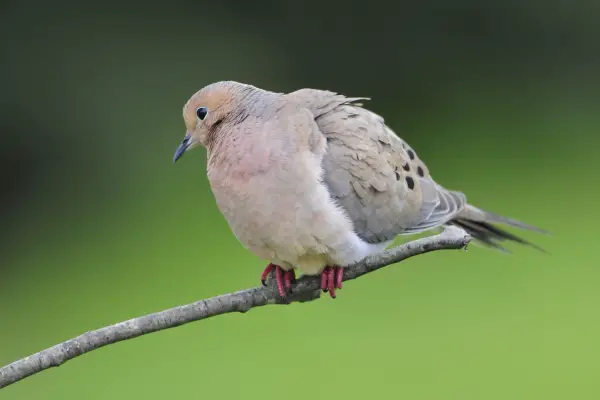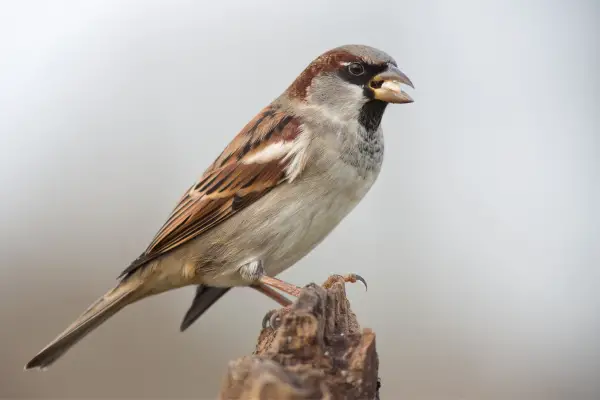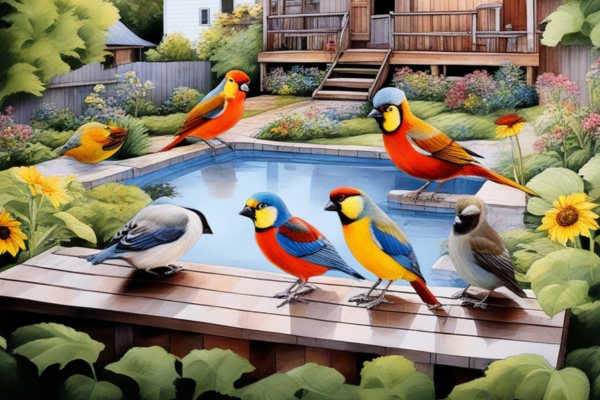15 Backyard Birds
The hummingbirds, chickadees, sparrows, and other birds that flock to our yards offer a prime opportunity to connect with nature close to home. Getting to know these backyard visitors at a glance can enrich the backyard birding experience and help attract some new feathery friends.
So here’s your guide to identifying 15 birds commonly seen in yards across North America, along with tips on what to plant and provide to bring in more of your favorite winged species.
Getting to Know 15 Fascinating Backyard Birds
Backyard Bird #1: Northern Cardinal
The brilliant red plumage of the male Northern Cardinal makes it an unmistakable flashing streak in many yards, gardens and parks. Both sexes sing, though the male’s loud whistle is more recognizable.
Standing 8-9 inches tall, cardinals prefer thickets and hedgerows where they can hop along in search of seeds, berries and insects . Offer safflower seed, sunflower seed and fruiting shrubs like dogwood and holly.
Backyard Bird #2: Mourning Dove

With light brown feathers and distinct black spots on the wings, the graceful and slim Mourning Dove is a peacefully cooing visitor to platform feeders and ground seed offerings.
At 12 inches long these slender birds travel in pairs or groups, strutting across open yards and wooded edges as they peck and forage for seeds and grain. They enjoy most types of mixed bird seed.
Backyard Bird #3: Black-capped Chickadee
The feisty, active Black-capped Chickadee brings its chick-a-dee-dee song and acrobatics to many a winter backyard. At just 5 inches long, these birds travel in flocks that chase, dangle from branches and mob feeders.
They prefer black-oil sunflower seeds, suet and peanuts. Planting native vegetation attracts insects for breeding chickadees in springtime.
Backyard Bird #4: American Robin
One of the most familiar backyard birds in North America, the rusty orange breasted American Robin arrives in many areas in time to herald spring.
Reaching up to 11 inches in size, these thrushes use their strong bills to pull worms and insects from lawns and fields. They also enjoy berries. While open grassy areas are ideal, robins may nest in platforms and corners around homes.
Backyard Bird #5: Blue Jay

With brilliant blue and white markings, the Blue Jay is a showy, noisy visitor favoring yard edges near oak or beech trees. Omnivores that grow to 11 inches tall, Blue Jays hoard acorns as well as scoped up seed from platform feeders.
They enjoy peanuts, sunflower seed and suet. Though accused of bullying smaller birds, research suggests jays mainly displace each other at feeders, not smaller species.
Backyard Bird #6: Tufted Titmouse
The cute crested Tufted Titmouse shows up readily at seed feeders, flitting about with chickadees and nuthatches. Weighing just over half an ounce, these gray 6-inch birds consume a wide variety of seeds and insects.
Offer them suet, sunflower seeds and peanuts in mesh feeders or hanging logs, ideally near deciduous oak woodland to attract breeding populations in springtime.
Backyard Bird #7: House Finch
The males live up to the House Finch’s name, flashing bright red heads and throats around backyard feeders and nests. More subdued brown females also visit seed and fruit offerings. House Finches reach nearly 6 inches long and may flock with sparrows or travel in small groups.
They favor black-oil sunflower but eat a variety of seeds, fruits and vegetation. Tubular hanging feeders allow access while deterring larger birds .
Backyard Bird #8: House Sparrow

Generations of homeowners have enjoyed the swift, darting movements of these small brown and gray birds around their homes. House Sparrows only reach 6 inches in size but maintain a large presence with noisy chatter and busy activity. They scavenge most seed from platform or hopper feeders but prefer smaller millet. Where considered invasive, sparrows may be discouraged with feeders restrictive to smaller birds.
Backyard Bird #9: Dark-eyed Junco
The handsome slate gray Junco with its frosty white belly often arrives at northerly backyards when snow starts falling.
These small sparrows reach just 6 inches tall but gather in sizable mixed flocks called headphones when feeding due to how they all pop down at once. Juncos like mixed birdseed, particularly small seeds, and objects to hunker under like low shrubs.
Backyard Bird #10: Downy Woodpecker

Iconic black and white markings make Downy Woodpeckers a charming sight as they cling to trunks and branches probing for insects. Males sport a crimson patch on the back of their heads. At just 6-7 inches in size, these birds are the smallest woodpeckers. Suet, peanuts and nut blocks appeal to them, as do trees left partly dead or dying .
Backyard Bird #11: White-breasted Nuthatch
The agile White-breasted Nuthatch regularly joins chickadees, titmice and woodpeckers at backyard offerings, especially suet feeders. These blue-gray birds reach nearly 6 inches tall, using strong claws to move up and down and even upside down along trunks as they hunt for insects. They make unique nasal yelping calls. Offering shelled peanuts and sunflower seeds brings them in.
Backyard Bird #12: European Starling

Though an invasive species, the iridescent purple and green colored European Starling does well around backyard feeders across most of North America.
With a wingspan of nearly 12 inches, these strong fliers travel in enormous dynamic flocks called murmurations to mob food offerings where availability allows, especially suet or animal fat. They nest in cavities providing nest boxes.
Backyard Bird #13: Red-bellied Woodpecker
Though named for the reddish patch on males barely visible except at close range, the bold black and white barred backs make Red-bellied Woodpeckers easy to recognize.
Nearly crow sized at 9-10 inches, these birds call attention to themselves at suet and seed feeders. Offer them suet, seeds and consider putting up nest boxes as habitat loss threatens populations of this insect-eating species.
Backyard Bird #14: Ruby-throated Hummingbird
The metallic green and red male Ruby-throated Hummingbird that zips into yards every summer defending nectar feeders has migrated thousands of miles from Central America, with the female soon to follow.
Tiny at just 3-4 inches long, these energetic birds consume more than their weight daily in flower nectar and small insects when establishing breeding territories.
Backyard Bird #15: American Goldfinch
The bright yellow male American Goldfinch sporting a jaunty black cap signals warmer seasons have arrived and it’s time to stock nyger seed offerings. These birds transform in spring from their olive-colored winter coat when flocks descend to nibble seeds and fruits.
Measuring 5 inches long and preferring open areas with scattered seed plants and shrubs, goldfinches chirp and flutter softly about their feeding.
Attracting Backyard Birds
Understanding favorite foods, nesting preferences and migration patterns helps draw backyard birds to appreciate and enjoy. Tailoring yards to include native plants that provide seeds, fruits, cover and nesting spots welcomes a diversity of species. Maintaining fresh water for bathing and drinking also appeals to birds.
Depending on the kinds of birds desired, once basic needs are met, offering the appropriate feeders and favored seeds invites these winged wonders to stay awhile. Developing a yard birds will flock to visit provides a relaxing, rewarding way to connect with wildlife.


